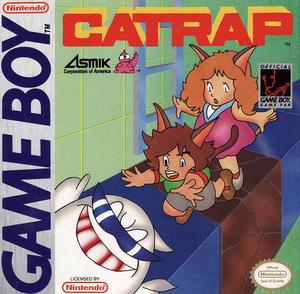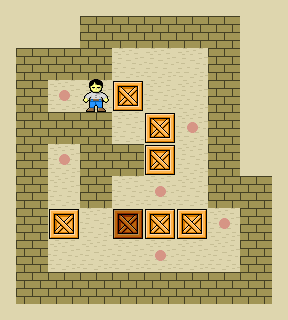 W
WA-Train is a series of business simulation video games that were originally developed and published by Japanese game developer Artdink in Japan. The first game in the series was published in 1985. The first release in the United States was Take the A-Train II, published in 1988 by the Seika Corporation under the title Railroad Empire. However, the most well known U.S. release is Take the A-Train III, published in 1992 by Maxis as simply A-Train.
 W
WArchon: The Light and the Dark is a 1983 video game developed by Free Fall Associates and one of the first five games published by Electronic Arts. It is superficially similar to chess, in that it takes place on a board with alternating black and white squares; however, instead of fixed rules when landing on another player's piece, an arcade-style fight takes place to determine the victor, and each piece has different combat abilities. The health of the player's piece is enhanced when landing on a square of one's own color.
 W
WBattle City is a multi-directional shooter video game for the Family Computer produced and published in 1985 by Namco. It is a successor to Namco's 1980 Tank Battalion, and would be succeeded itself by the 1991 Tank Force.
 W
WBinary Land is a puzzle video game developed by Hudson Soft in 1983 for the MSX, FM-7, NEC PC-6001, NEC PC-8801, and in 1985 for the Famicom. The MSX version saw release in Japan by Hudson Soft and in Europe by Kuma Computers Ltd in 1984.
 W
WThe Black Onyx is a 1984 role-playing video game released in Japan, developed by Bullet-Proof Software, with development led by Henk Rogers. It was originally released for the NEC PC-8801, and ported to several other platforms. The Famicom version featured completely redesigned gameplay, a new map, and was retitled Super Black Onyx (スーパーブラックオニキス). The Game Boy Color port was developed by Atelier Double and published by Taito. The Game Boy Color port added enhanced visuals and included an option to play through the game with the original game's visual style.
 W
WBomberman is an arcade-style maze-based video game developed by Hudson Soft. The original home computer game Bomber Man was released in July 1983 for the NEC PC-8801, NEC PC-6001 mkII, Fujitsu FM-7, Sharp MZ-700, Sharp MZ-2000, Sharp X1 and MSX in Japan, and a graphically modified version for the MSX and ZX Spectrum in Europe as Eric and the Floaters. It had a Japanese sequel known as 3-D Bomberman, in which Bomberman navigates the maze in the first-person. In 1985, Bomberman was released for the Nintendo Entertainment System. It spawned the Bomberman series with many installments building on its basic gameplay.
 W
WCatrap, known as Pitman in Japan, is a puzzle-platform game developed for the Sharp MZ-700 computer in 1985 and released by Asmik for the Nintendo Game Boy in 1990. The Game Boy version was rereleased on the Nintendo 3DS Virtual Console in October 2011. Destructoid credits the game with using a time-rewind mechanic before games like Blinx, Prince of Persia: The Sands of Time, and Braid.
 W
WChack'n Pop is an platform arcade game developed and released by Taito in 1984. In the game, the player controls a small yellow creature, Chack'n, with the objective being to retrieve hearts from a cave, all while avoiding the enemies contained within them. Chack'n also has the ability to deploy bombs, which can kill said enemies, which can bring bonuses depending on if the all or none of the enemies have been killed.
 W
WCrazy Climber is a vertical scrolling arcade climbing game produced by Nichibutsu and released in 1980 worldwide. In North America, the game was also released by Taito America. It was later released by UA Ltd. in 1982 for the Emerson Arcadia 2001 and other video game consoles. It is one of the most acclaimed games in Nichibutsu's library. A precursor to the platform game genre, Crazy Climber was the first climbing-themed video game—specifically, climbing buildings—before Nintendo's 1981 release Donkey Kong.
 W
WDark Side is a 1988 video game published by Incentive Software for the Amiga, Atari ST, Amstrad CPC, Commodore 64, IBM PC compatibles, ZX Spectrum, and Sharp MZ-800. The game is a sequel to Driller, set in the Evath system but this time on Evath's second moon Tricuspid.
 W
WDoor Door is a 1983 single-screen platform video game developed and published by Enix in Japan. Originally released for the NEC PC-8801, it was ported to a number of other platforms, including the Family Computer. Controlling a small character named Chun, the player is tasked with completing each stage by trapping different kinds of aliens behind sliding doors. Chun can jump over the aliens and climb ladders, and must also avoid obstacles such as large nails and bombs.
 W
WFlappy is a puzzle game by dB-Soft in the same vein as the Eggerland series and Sokoban that is obscure outside Japan. It features Flappy, a somewhat mole-like character who must complete each level by pushing a blue stone from its starting place to the blue tile destination.
 W
WFlicky is a platform game developed by Sega and released in arcades in May 1984. It was licensed to Bally Midway for distribution in the United States. In Flicky, the player controls the eponymous blue bird and must gather all the small birds called Chirps in each round and bring them safely to the exit. There are cat and lizard enemies which can disperse the Chirps and kill the player, but Flicky can use items on the playing field to protect herself and the Chirps from danger.
 W
WFront Line is a military-themed run-and-gun shooter game released by Taito for arcades in 1982. It was one of the first overhead run-and-gun shooters, a precursor to many similarly-themed games of the mid-to-late 1980s. The original arcade version of Front Line is controlled with a joystick, a single button, and a rotary dial that can be pushed in like a button. The single button is used to throw grenades and to enter and exit tanks, while the rotary dial controls and fires the player's gun.
 W
WGenghis Khan, original full title Aoki Ōkami to Shiroki Mejika: Genghis Khan (蒼き狼と白き牝鹿・ジンギスカン), is a 1987 turn-based strategy game developed by Koei, originally released for the NEC PC-9801, MSX and Sharp X68000 in 1988, the DOS and NES in 1990, and the Amiga in 1990. It is actually the second game in the series, after a 1985 Aoki Ōkami to Shiroki Mejika, also for PC-88, PC-98, and MSX.
 W
WGrobda is a 1984 multi-directional shooter arcade game developed and published by Namco. It is a spin-off from Xevious, as the player's tank first appeared in that game as an enemy. It runs on Namco Super Pac-Man hardware but with a video system like that used in Mappy and The Tower of Druaga, and it also uses a DAC for the "Get Ready" speech sample at the start of each round.
 W
WHlípa is a 1989 video game developed by two developers from Prague. It is a maze game which is considered to be the most complex game for PMD 85. The game was later ported to Atari ST and Sharp MZ.
 W
WHydlide is an action role-playing game developed and published by T&E Soft. It was originally released for the NEC PC-6001 and PC-8801 computers in 1984, in Japan only; ports for the MSX, MSX2, FM-7 and NEC PC-9801 were released the following year.
 W
WLode Runner is a 2D puzzle-platform game, developed by Douglas E. Smith and published by Broderbund in 1983. Its game-play mechanics are the same as in Space Panic from 1980. The player controls a character who must collect all the gold pieces in a level and get to the end while being chased by a number of enemies. It is one of the first games to include a level editor.
 W
WMappy is an arcade game by Namco, introduced in 1983 and distributed in the United States by Bally Midway. A side-scrolling platform game featuring a mouse protagonist and cat antagonists, it runs on Namco Super Pac-Man hardware modified to support horizontal scrolling. The name "Mappy" is likely derived from mappo (マッポ), a slightly pejorative Japanese slang term for policeman. The game has been re-released in several Namco arcade compilations. It spawned a handful of sequels and a 2013 animated web series developed by cartoonists Scott Kurtz and Kris Straub.
 W
WPac-Man is a 1980 maze action video game developed and released by Namco for arcades. The original Japanese title of Puck Man was changed to Pac-Man for international releases as a preventative measure against defacement of the arcade machines by changing the P to an F. In North America, the game was released by Midway Manufacturing as part of its licensing agreement with Namco America. The player controls Pac-Man, who must eat all the dots inside an enclosed maze while avoiding four colored ghosts. Eating large flashing dots called "Power Pellets" causes the ghosts to turn blue, allowing Pac-Man to eat them for bonus points.
 W
WPenguin Wars is an arcade game released in 1985 by UPL. It was ported to the original Game Boy (1990), MSX and Nintendo Entertainment System by ASCII under the title Penguin Wars. The Game Boy version of the game is known as King of the Zoo in Europe and Penguin-Kun Wars Vs. in Japan. The main background music in most versions of the game is an electronic rendition of "Motto Sekkin Shimasho" a song originally performed by 1980s J-Pop singer Hidemi Ishikawa .
 W
WPoibos Part 1: Dasshutsu is a sci-fi role-playing video game released by ZAT-SOFT for various computer platforms in Japan in 1983. It was originally developed on the premise of sequels, but only the first game was released. Planet name "Poibos" is a reference to the god Phoebus from Greek mythology, with simplified spelling for a Japanese audience. Poibos Part 1 is one of the first JRPGs ever created, and the first one in a sci-fi setting.
 W
WPrincess Tomato in the Salad Kingdom is a video game by Hudson Soft originally released in 1984 for the NEC PC-8801, NEC PC-6001, FM-7 and MSX Japanese home computers.
 W
WSokoban is a puzzle video game genre in which the player pushes crates or boxes around in a warehouse, trying to get them to storage locations.
 W
WSuper Xevious is a 1984 vertical-scrolling shooter arcade game developed and published by Namco in Japan. It is an updated version of Xevious (1983), created as a response to the overwhelming success of the original in Japan. Like the original game, the player controls a starship known as the "Solvalou", equipped with two weapons: an "air zapper" to defeat flying enemies, and a "blaster bomb" to destroy ground-based enemies. It runs on the Namco Galaga arcade board. New enemy types include metallic Galaxian flagships. Some of these revert the player's score to zero if destroyed. It has been ported to the Sharp X68000 and PlayStation, alongside inclusion in several Namco collections.
 W
WThexder is a run-and-gun platform game from Game Arts, originally released for the NEC PC-8801 in 1985. It was subsequently ported to many other systems, including the Famicom.
 W
WThunder Force is a free-roaming scrolling shooter computer game released by Technosoft in 1983. It is the first game in the Thunder Force series. It was initially released for the X1 computer, and later appeared on the Sharp MZ-1500, PC-6001 mkII, and in 1985 on the PC-8801 mkII. In 1984, it was released for the FM-7 and PC-9801 computers as Thunder Force Construction, featuring an add-on that allowed players to create custom made areas, like a level editor or game creation system.